Last year, as inspired by Steve Jackson Games, I released our first stakeholder report. A “stakeholder” in Stonemaier Games is anyone who has an impact on our company and a stake in our success, whether it’s employees, contractors, fans, retailers, distributors, volunteers, artists, designers, backers, readers, etc.
I received the 2017 K-1 tax document from our accountant earlier this week, so it’s time for this year’s stakeholder report. As usual, there’s a lot of information, but I’ll try to break it down into various sections.
 2017 Revenue and Personnel
2017 Revenue and Personnel
We use the accrual method for accounting (expenses and revenue count in the year when we ship the products to the customer). 99.9% of our sales in 2017 were to distributors.
- Revenue: $7.1 million
- Full-time employees: 1
- New games: 1
- New expansions: 2
- Crowdfunding campaigns: 0
![]()
For comparison, revenue was $3.5 million in 2016. However, our profit did not double in 2017, as manufacturing (Panda) and shipping (OTX) continue to be monumental costs for us, and we haven’t let any of our products go out of print. So a significant portion of our revenue is simply reinvested in reprints. We were profitable, though.
We have no debt, nor did we take any loans in 2017. We did, however, offer distributors the opportunity to pre-pay for our big holiday print run, as we don’t have millions of dollars in cash just sitting in the bank.
I (Jamey) am still our only full-time employee, and Alan and Morten work a combined 10 hours a week. We use a LOT of independent contractors, though (artists, graphic designers, web devs, proofreaders, playtesters, etc). I own 90% of the company, and the rest is divided between a few key parties.
We also continue to contract Greater Than Games to provide warehousing and distribution brokerage for our products. I still run Stonemaier Games out of my home office, which is also in St. Louis. I like having a 5-second commute from bed to desk.
We have a number of different SKUs (expansions, accessories, promos, realistic resources, etc), but our core products are 5 games. The quantities below are the lifetime units in circulation for each game in any language as of the end of 2017, and the BGG rankings are as of today.
- Viticulture: 54,780 (BGG rank: 19)
- Euphoria: 31,000 (BGG rank: 312)
- Between Two Cities: 36,900 (BGG rank: 475)
- Scythe: 147,678 (BGG rank: 8)
- Charterstone: 56,500 (BGG rank: 98)
Our margins continue to be a little less than what we need for long-term stability. That is, while industry norms are for a game’s MSRP to be 5x-7x a game’s manufacturing cost, some of our games are 4x the manufacturing cost (e.g., Scythe probably should be a $95 game, and Charterstone should be an $80 game). I’ll continue to keep the consumer in mind in terms of price and component quality while ensuring that our margins are good enough to stay in business.
Our strategy continues to be to release 1-2 new games and a few expansions each year. So far, 4 of our 5 games were designed by me, but our next 4 games were designed by other designers (though I’ve had a hand as a developer in all of them).
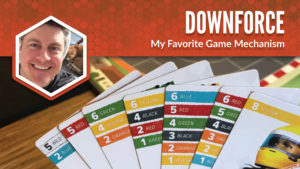
Social Media and Other Metrics
These numbers are as of today.
- e-newsletter subscribers: 33,280 (55% open rate)
- Facebook fans: 13,958 (though most interactions are in our Facebook groups, which have over 20,000 members)
- Twitter followers: 9,262 (40% increase)
- YouTube subscribers: 6,036 (98% increase)
- Instagram followers: 2,133
- Stonemaier Champions: 188
- ambassadors (active volunteers): 1,686
- retailer/distributor mailing list: 547
- international localization partners: 25
- website Alexa ranking: 103,546 (avg. 5094 views per day in 2017)
- Stonemaier Games Design Day attendees: 85
- game submissions (including Gen Con): 184
- funds raised by annual charity auction: $11,150
- number of cats (full time): 2
I’m happy with these numbers. I mostly look for steady growth from year to year without manipulation (I don’t run contests or giveaways to get people to subscribe–I only want people to subscribe if they’re genuinely interested in the content), and that seems to be happening in all areas where I’m interested in growth.
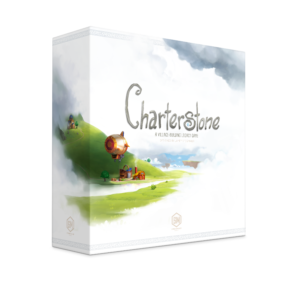 New Products and Campaigns in 2017
New Products and Campaigns in 2017
- Between Two Cities: Capitals expansion (May 2017)
- Legendary Box (December 2017)
- Scythe: The Wind Gambit expansion (December 2017)
- Charterstone and the Charterstone recharge pack (December 2017)
As you can see, our 2017 was extremely backloaded. That is not my preference–I’d rather new releases be spread out a bit for the sake of our cash flow, consumers, and retailers. This wasn’t the plan, but some pre-production and manufacturing issues bumped Charterstone back several months from the original estimated release month.
Biggest Changes and Mistakes
Many of the changes I discussed in this section of the 2016 stakeholder report still feel new to me, so I’d recommend looking at that if you’re curious. Here’s the new stuff.
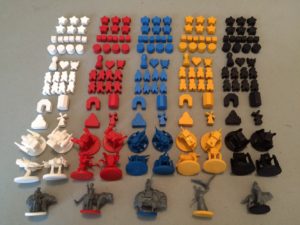 Too much wood: In a November blog post I talked about some of the implications of our 200,000-unit holiday print run we initiated in May 2017. One thing I didn’t mention is that we ordered so much wood all at once that the factory couldn’t keep up, causing a significant delay in our flagship product, Scythe. In the future I’ll spread out print runs more, communicate priorities better with our manufacturer, and I’ll start the holiday print run even earlier (I’m literally starting our holiday print run in 2 weeks–yes, in mid-March I’m starting to print games that I expect to sell to distributors for November/December retail sales).
Too much wood: In a November blog post I talked about some of the implications of our 200,000-unit holiday print run we initiated in May 2017. One thing I didn’t mention is that we ordered so much wood all at once that the factory couldn’t keep up, causing a significant delay in our flagship product, Scythe. In the future I’ll spread out print runs more, communicate priorities better with our manufacturer, and I’ll start the holiday print run even earlier (I’m literally starting our holiday print run in 2 weeks–yes, in mid-March I’m starting to print games that I expect to sell to distributors for November/December retail sales).- Co-designs: Several times in 2017–for both Scythe expansions and for the unannounced Viticulture expansion–fans of our games created the early stages of expansions, posted them either on social media or privately to me, and we ended up working together to design the expansion. I found that I really enjoyed this collaborative process, specifically for expansions.
- Playtesters (quality over quantity): We’re lucky to have a lot of people who are willing to blind playtest our games, but this was the first year I embraced the idea that I‘d rather have (and pay) skilled playtesters than have a mass of semi-useful feedback.
- Submissions: A huge part of my co-founder’s job now is to review submissions, for which we only had limited capacity in the past. I created a detailed form for designers to fill out that details exactly what we’re looking for.
- Job applications: Even though we don’t have any available positions, I realized that I may be missing out on quality applicants if I didn’t have a place for people to apply for a job. So we now have a job application where anyone can tell us how they think they can make Stonemaier better (though I’ll reiterate that I think by far the best way to get your foot in the door in the game industry is to start by volunteering).
- Acquisition: For the first time in Stonemaier history, a company kind of tried to buy us! It was quite a surprise, and even though it wasn’t something I was interested in, it was interesting to learn a little about the process in case it’s something we want to consider in the future (either as the buyer or the seller).
- S-Corp conversion: I’m not an accounting guy, so I still don’t fully understand the difference between an LLC (which we were) and an S-Corp (which we now are), but all I know is that it’s supposed to be better for us tax-wise. If you feel like you pay half of your profit in taxes, consider talking to your accountant about a conversion.
 Website Home Page: Our excellent web designer, Dave Hewer, revamped our home page.
Website Home Page: Our excellent web designer, Dave Hewer, revamped our home page.- Release Dates: This was the first year we really had ironclad release dates. As you can see in this article, I think the implementation can be improved by all parties involved, and this year I’m going to try to do my part and get games to distributors at least several weeks before the release date.
- Legendary Box: I attempted to sell a product–a big empty box for Scythe–directly through a few different retailers around the world instead of through distributors so I could make the MSRP lower. This ended up frustrating retailers and distributors, as well as consumers who wanted to buy from a specific store. So if/when we make more of these, they’ll be priced for selling to distributors.
- Localization partners: We’re fortunate to have some fantastic international publishing partners to extend our reach to people who speak other languages around the world. We’ll continue working with them, but instead of holding up the English version of the game by 2 months until the translations are ready (as we did with Charterstone), we’re going to proceed with an English first print run, followed by an international second print run a few months later.
- Still No Digital: Every year for the last few years I’ve said that this will be the year that we finally have a full-AI digital port of one of our games…yet it hasn’t happened. It’s not due to lack of effort–there have been developers working on these games. It’s just that they’ve taken much, much longer to create than I was originally told. I’m confident Scythe will finally be available via digital port in 2018, followed by Viticulture and Charterstone in 2019.
- New Releases: We plan to release 2-3 new games in 2018, 2-3 new expansions, and 2 new accessories in 2018. We also created 3 new realistic resource tokens that are available for pre-order from Top Shelf Gamer.
- In the Works: I’m currently designing 3 games, all of which are completely different than anything I’ve done before. One involves an IP. They’re currently all potential 2019 releases.
- Revenue: I suspect that our overall revenue may go down in 2018, and I don’t think that’s a bad thing. There were just a few points in 2017 where cash flow dipped precipitously low due to the cyclical nature of making and selling games, and always want to be able to pay our partners right away. This means more conservative print runs, fewer reprints, and less risk.
- Announcements: I’m trying–somewhat unsuccessfully so far–to announce new games about 1-2 months before their release dates (unlike with Charterstone, which had a huge gap between announcement and actual release). That way you can get excited about something new and actually have it soon afterwards while still having some time to budget.
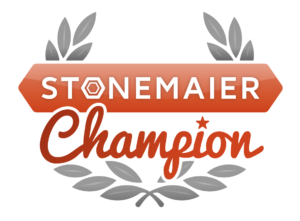 Stonemaier Champion: As announced last week, we finally created a way for the people who read this blog and listen to my YouTube channel can financially support that content (while getting some special perks for their contribution).
Stonemaier Champion: As announced last week, we finally created a way for the people who read this blog and listen to my YouTube channel can financially support that content (while getting some special perks for their contribution).- Facebook Live: So far, 2018 has been the year of live video. It’s a format I was late to embrace (similar to Instagram), but I now have a good rhythm of hosting a live chat every Wednesday at 10:00 am on our Facebook page. The engagement has been awesome, so I’ve even started scheduling our monthly e-newsletter so I can be live to chat about it on Wednesday immediately after sending it.
- Gen Con and Gen Can’t: This will be the first year that we have both full use of a conference room and a big booth (shared with Meeplesource) at Gen Con. Conventions still aren’t part of our marketing strategy, but it still seems prudent to attend Gen Con. If possible, this year we’re going to send some pre-release copies of our Gen Con releases to retailers who run “Gen Can’t” events and want to feature those games. I might explore that “pre-release” concept even beyond Gen Can’t.
- No Kickstarter or Pre-Order Campaigns: While we’re still applying everything we learned from Kickstarter to create what we hope is a good experience for our fans, we’ll continue our strategy of not using Kickstarter (it’s been 2.5 years since our last campaign). Here’s why.
If you want to express your opinion/desire for anything we’re creating or considering, please fill out our future printing request survey.
I want to continue to learn, make mistakes, experiment, and listen to our stakeholders. Thank you for challenging me in healthy, constructive ways in 2017, and I look forward to experiencing the rest of 2018 with you.
Do you have any thoughts, observations, or questions about this report? Please let me know in the comments.
77 Comments on “2017 Behind-the-Scenes Stakeholder Report for Stonemaier Games”
Leave a Comment
If you ask a question about a specific card or ability, please type the exact text in your comment to help facilitate a speedy and precise answer.
Your comment may take a few minutes to publish. Antagonistic, rude, or degrading comments will be removed. Thank you.
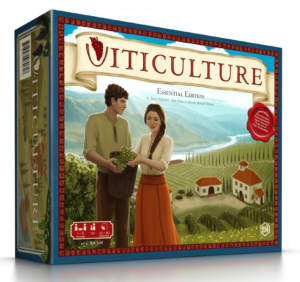
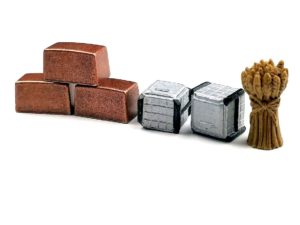


[…] 2017 Stakeholder Report […]
[…] 2017 Stakeholder Report […]
[…] existing, attentive audience: You can see our social media stats here if you’re curious. This is something that enables us to use this announcement method, while […]
[…] 2017 Stakeholder Report […]
[…] die eigenen Karten lässt sich aktuell der Verlag Stonemaier Games schauen. Im Rückblick auf das Jahr 2017 finden man interessante […]
Hi Jamey,
We would generally see sales to our distributors at 35% of MSRP with on-ward sales or direct sales to the retailers at 45-50% of MSRP.
These margins are probably similar for the Hobby games sector, but the key difference is the price point is so much higher to ensure the quality and distinctiveness of your genre of games.
All the best
Graeme
Jamey – How much of the $7.1 million is profit?
Not as much as I’d like. :)
Jamey, I am blown away by your open publication of your lifetime game sales and overall sales. Its evident from these numbers that you are not trying to impress anyone but show your followers and fellow game enthusiasts that you hold their interests above yours. By only achieving a 4x mark-up on some of your games, enthusiasts should be aware that in the mass market we need to be achieving an 8-9x multiple of Manufacturing costs to generate sustainable margin and bring the game in at the price point for mass retail. All of which impacts the quality of the game and components. I am determined to create a hybrid Hobby-Mass market game that straddles both segments and is respected by both sets of players. The challenge is on but thank you again for being so open.
Graeme
Graeme: Thanks for your note. That’s interesting to hear about mass market games–I wasn’t aware that the multiplier needed to be that high. At what discount do mass-market stores buy games? It must be a lot more than the 60% discount hobby distributors get.
Thanks for sharing this.
What was your estimated profit on that 7M and 3.5M?
Much lower than revenue. :)
Thanks Jamey. I ask because I’m trying to decide if I should go the publisher route, or self publish. Being that I have an existing small business, plus an existing job, plus a family, I’m wondering if the extra profit potential for self publishing would be worthwhile.
I figure if a publisher pays 10% of gross, a game needs to do $500k just to earn a paltry $50k. If self publishing yields closer to 20% or more, I’m thinking it could be worth the extra work.
Are those numbers realistic?
So, hypothetically, let’s say you’re involved in a game that makes total revenue in the first printing (split between Kickstarter and distribution) of $200,000. That’s optimistic, but possible. If you’re the designer of that game, a publisher will probably pay you 7%–the designers who make 10% are those who have made quite a name for themselves already. That’s $14,000 in taxable income for you.
If you’re the self-publisher of that same game and manage the game to a level of success equal to that of an established publisher (again, $200k), we need to dig a little deeper into the numbers to see what you walk away with. Like, say you made $150k on Kickstarter, selling 2000 games, each of which you sold for $39 on Kickstarter including a $10 shipping subsidy, and they each cost $10 to make. Factor in additional shipping costs and sunk costs like art, graphic design, marketing, etc, and we’ll say that your profit per game ends up being $15 each. You also make $50k via distribution (the game’s MSRP for this example is $50, so that’s $20 revenue per unit in distribution, meaning you sold another 2500 units via distribution. That’s $10 in profit per unit.
Overall, that adds up to $55,000 in profit if you choose not to make another print run and assuming everything goes perfectly, which it won’t. :)
[…] https://stonemaiergames.com/2017-behind-the-scenes-stakeholder-report-for-stonemaier-games/ […]
Hi Jamey, when you registered Stonemaier as a company what business category did you choose? I don’t think there’s one called board game publishing. I found these but none of them quite suit:
– Manufacture of games and toys
– Retail sale of games and toys in specialized stores
– Publishing of computer games
I think I chose a publishing option, as we’re not a manufacturer or a retailer.
:) Thanks. I suppose then anything will do that vaguely resembles it, unless you get a tough Mississippi judge.
This is really cool information to share, Jamey (as an aspiring publisher/deal attorney). I see tons of recommendations that designers not be publishers (and vice versa), but you seem to be the clear successful exception to the rule. I was just reading some posts about Vital Lacerda’s Kanban and how he can’t republish a deluxe version until his publisher relationship ends in 2019. I’m sure you already hold it as a holy rule, but CONTROL YOUR IP, always. Great job on everything and thanks from all of us for the transparency.
Willie: I like that advice (“control your IP”). That’s the case with most of our games, though for Scythe we only have the tabletop game rights.
Jamey,
In a previous post, I commented on both your humility and honesty and this level of transparency simply underscores why you have such a wonderful [I’m reticent to use the word “devout” :)] followers, but among the hundreds of designers and thousands of developers, you do stand alone in terms of accessibility and willingness to share. And by share, you provide valuable information on your successes and failures (which points to your humility), as others, like myself as a designer and developer, can learn equally from both of those scenarios.
Again, thank you!
Cheers,
Joe
What you said is very important. I think most people would fall into the same split, putting too much value on money because we are thought that way from every angle. I’m happy to hear it all worked out in the end. You put the maier in Stonemaier :)
It’s also great that all your games will continue producing revenue for you and your designers for many years to come. With the exponential growth of new board game customers it’s not crazy to think your games may have a million copies sold in the next few years. In 20 years probably your top IPs would have over a million copies sold each. I wonder how giant board game companies do it now, and is it more than just money for marketing. Viticulture is better than Carcassonne and Ticket to Ride.
I pity your long commute to work. You should try moving your office in to your bedroom :)
I agree! I’m very, very lucky that Alan is so reasonable.
A million copies is a lot–that would be great! I’m happy to keep printing our games as long as people want them. :)
I’m sure people will still be recommending your games in 20 years like they do today with Catan, and Carcassonne. And how big will the market be then (unless it’s a Brave New World). Something to think about if Asmodee ever want to buy your company.
Thanks for the great information. I’m sure it will help lots of people in similar situations. Your previous reply made me think that if you design the game then it’s fair that you should get 10% of the game revenue on top of your employee and director salary, as that would be the cost for your company for games you don’t design yourself. You’d have to think about those royalty contract too if you ever did sell the company.
What I said above was not clear. I meant that it might be a good idea if you had a Stonemaier designer’s contract yourself.
If years in the future Stonemaier Games was sold then you would get x% of any reprints for Viticulture, Euphoria, Scythe, and the new Jamey Stegmaier games. Plus credit as the designer for those. If there aren’t any designer contracts for those games then who knows what a big corporation might feel justified to do. I just hope you’re safeguarded against that. It’s amazing you get all this stuff done in a year, plus more. I can see why you need to work 80+ hours per week.
I understood! :)
Fascinating read. I’ve bookmarked to read again.
You’ve already shared so much and been so open that my two questions would probably be too much, and that is fine if you cannot answer them.
From Alan’s point of view it must also be an amazing success story. I assume Alan invested in Stonemaier when you create the Viticulture prototype. I can guess a person might invest $1,000 to $5,000 (or even $10k) for 10% at that stage. Would that be close? If he did then what a smart entrepreneurial move.
Approximately what are the cost for game designers? Would it be $1 per game, $2, $3, $4, $5 per game?
I won’t go into the details of the original investment, but I basically did everything wrong at that early stage (there’s . Me, Alan, and someone else each invested a very small amount of money–the same amount each–to pay for some Viticulture art. Since we all paid the same amount, I thought the right thing to do was to split the company into thirds. Quickly I realized that was a huge mistake, because I was doing 90% of the work, and the money–while helpful–was really just risk mitigation (it was truly a very small amount). Fortunately, we ended up resolving things a while later, reorganizing the equity so I own 90%, and the other 10% is split between Alan, our graphic designer, and an investor to whom Alan sold some of his shares. Based on his original investment, Alan got an excellent return on investment.
We pay game designers 7-10% royalties on revenue (if there’s more than one designer, they split the royalty).
[…] Stonemaier Games Stakeholder Report Jamey Steigmaier recently posted a behind-the-scenes Stonemaier Games stakeholder report, offering his thoughts on the company’s changes and mistakes as well as discussing upcoming plans. “I suspect that our overall revenue may go down in 2018, and I don’t think that’s a bad thing. There were just a few points in 2017 where cash flow dipped precipitously low due to the cyclical nature of making and selling games, and always want to be able to pay our partners right away.” Source: https://stonemaiergames.com/2017-behind-the-scenes-stakeholder-report-for-stonemaier-games/ […]
Hi, Jamey. Regular reader of your blog and therefore a Stonemaier Champion. I’m a big believer in transparency. I read once that “sunlight is the best antiseptic.” and live by that value. But it has an air of vulnerability so requires courage and an enlightened perspective. Thank you for having both those traits and continually demonstrating it.
It helps me as a business owner to understand another business’s challenges and successes. As I’m sure it helps many other current and aspiring business owners (and game designers).
I still have aspirations some day to be an active blogger and social media poster. Your work, like this blog post, is a model for me when that day arrives.
Thanks for everything!
Thanks Chad! I’ve never heard that saying about sunlight, but I like it–I’m glad you mentioned it. It’s very helpful for me to look at my company through this lens, and I appreciate that readers like you give me that opportunity.
Jamey, I just had to leave a comment here. I am a big fan of your games and reading this report was so eye-opening. The numbers here fascinate me, both in the number of lifetime units in circulation and for the profit. I am curious how sales work though. Often I see preorder bonsues for games on seller sites. Is this something you do or the site does? Does the site buy the product from you at a specified price and then set their pre-order numbers, or do you get any of this?
Additionally, when estimating manufacturing numbers, do you gauge this based on market research, pre-orders, or guesses? You said you were starting a print run of an unnanounced game, but how do you know how many units to make?
Sorry for all of the questions, the honesty here is enlightening and I couldn’t resist asking. Please keep up the amazing work and I look forward to reading/buying/playing anything you are involved in in the future.
Mike: Thanks for your questions. I’m going to post a few links below to answer most of them, but I’ll also answer what these posts don’t address.
https://stonemaiergames.com/board-game-supply-chain-basics/
https://stonemaiergames.com/kickstarter-lesson-184-how-many-units-should-you-make/
https://stonemaiergames.com/lessons-learned-from-quitting-kickstarter-as-a-creator-part-2/
If you see a game for pre-order on an online retailer (like CoolStuff) and they’re offering a special promo or bonus, most likely they created that promo, though it’s possible they worked with the publisher to offer it (look at the fine print). Retailers buy from distributors, and distributors buy from publishers (see the article about supply chain).
Fantastic! Thanks for your reply!
[…] what subset of board game owners log their ownership on BGG (BoardGameGeek). Jamey Stegmaier just shared the installed base of five core products. I cross-referenced that against BGG ownership […]
When I read the first bulletins, I thought, “what, no full-time cats?” Then I relaxed.
About “Acquisition”: I think you speak very fast but think very carefully, Jamey. You at least had the wisdom to gain something from that too. It wouldn’t be surprising to see SM Games owning others’ titles in the future.
About “In the Works”: Only IP I can assume thinking of Jamey, is Smurfs! And in a good way of course.
P.S. Is Gen Can’t a thing now? We might consider it too!
Harry: Indeed, the cats are still on board. They essentially run the company.
I bet there’s a Smurfs game out there. :) What’s your dream IP?
I think Gen Can’t is a thing! I’ve heard of retailers running Gen Can’t events, as it’s a nice excuse for people to gather if they can’t attend Gen Con.
Good for Biddy and Walter!
My dream IP.. It may be like that, a dream. A theme not based on any other idea, an original; if only I could think of that. I like dreaming huh..
a Gen Can’t discount is all I could think of as an excuse for not attending, but sure some people think more creatively!
It is safe to discuss personal financial stuff online.. is it? From an accountant’s point of view :P
I think so! As long as your accountant does your taxes correctly. :)
Jamey thanks for being such a great ambassador for the entire Board Gaming hobby! All 5 games in the top 500 and 3 in the top 100 is just one example of how amazing you and Stonemaier Games are.
I’m halfway through the Crowdfunding Guide and try to keep up with your blog and tips so thank you for those as well. Any thoughts on an any actual conventions of events designed around learning about designing and publishing? Sometimes I feel like I’d like to just get away for a few days and be in more of a conference style learning environment.
Thanks for checking out my book, Aaron! I’d recommend any playtesting events like Protospiel, Unpub, and the Stonemaier Games Design Day–I learn a lot from other designers and publishers at those events. There’s also GDC (Game Developer’s Conference). It’s more focused on digital games, but there’s a growing tabletop focus there.
Jamey, I am continually floored by your consistent, open, honest appreaoch to the business as well as your willingness for share the process with others. I love getting to look “under the hood” of how the gaming industry works. Thank you for all you do for our hobby.
I really appreciate that, Toby! And thanks for becoming our 200th champion!
These stakeholder reports have been extremely interesting and informative to me both as a fan and a fledgling designer. Thanks for the continued information and inspiration, Jamey!
Thanks Jason! If there’s any other information I can provide on these reports that would help other designers, please let me know.
Have been a reader of your company and newsletter updates from the beginning and I continue to find your combination of joy, concern for your customers, and clarity of thought to be freaking delighting. Thank you, Jamey and have a great 2018!
Thanks Jesus! That means a lot coming from you–I admire people who try to put themselves in the shoes of the customer (in the many different forms the customer takes), and you’ve always seemed to do that so naturally.
Awesome read, Jamey. Have really enjoyed watching the growth over the past several years. We haven’t caught up with every game and expansion but hope to soon. Keep up the excellent work!
Thanks Jonathan!
Hey Jamey, thanks for sharing all this fantastic info. It’s great to see both the transparency and your growth!
As the sole owner of the company, I was curious how you decide to pay yourself. Do you give yourself a regular salary, pay yourself dividends, bonuses, or some combination? Since you depend on revenue from game sales (which can fluctuate) and re-invest quite a bit back into your company, I wondered what method you find works best.
Keep up the amazing work!
Cheers,
Joe
Thanks Joe! I pay myself a salary (well, the company does). I don’t make royalties on the games I design. There is the potential for a small dividend at the end of the year, though it depends on cash flow at the time.
Thanks Jamey! That’s helpful.
The other thing I was thinking that would make your post even better would be a comparison to last year for your figures to show how much Stonemaier Games has grown. I know you mentioned this for your revenue, but it would be great to see something like:
e-newsletter subscribers: 33,280 (up x% from # last year)
Thanks again for all your awesomeness!
That’s a great idea! There’s also the link if you want to see last year’s report, but I agree that it’s easier to see the difference here if I mention it here.
I am awed everytime i peak into your mind Jamey. I love seing the report as i am trying to understand what worked well and what worked better in the choices you’ve made, through the years of your business…
What do you consider were the choices that really made a difference in your early years, that lead to the success of this financial report (being positive in chashflow / having a well recognised company with tons of followers / older games that still impact players) ?
Thanks for all that you’re doing for the community…
p.s. if you have a blog post that explain these, please share it, i really wanna know…
Haralampos: That’s a great question. I think I’ve probably made far more mistakes than choices that led to success (though perhaps some of our success has come from how I responded to those mistakes).
This is such a great question that I’d like to ponder it for a full blog post, not rush for a quick soundbite here. :) I’ll make a note of it. Thanks!
Jamie, is there a reason you went S-Corp vs a newer entity called a B-Corp (benefit corporation). Usually articles of incorporation for an S involve maximizing shareholder value. The new B corporations allow for a public good (teaching Kids to read, saving the rainforest, or spreading the love of gaming across the world) can be a dictating force within the company. While it may not be worth it at this moment (due to having just made a change this year), you should talk to your attorneys about this option. It seems to fit your personality well of making the world a better place than you found it.
Ben: The S-corp was recommended for tax purposes by my accountant. While our core mission is to bring joy to tabletops worldwide, we want to do so in a profitable way, and my cursory look at B-corps didn’t seem like a good fit. However, I appreciate the heads up, and we’ll look into it.
I am so proud to work in an industry with such amazing people and companies like you and Stonemaier. Keep up the good work! Thanks for the transparency!
Thanks Andrew! My pleasure. :)
Thanks for the report. I’ve always loved reading the SJ Games report to stakeholders as it’s great insight into the company and how things flow.
I appreciate the transparency. I’d love to collaborate sometime. I guess I just need to make a fan derived expansion for one of your games!
Thanks Bob! I love seeing fan expansions, even if they just end up being a fun addition for fans of the game to explore. I think there might be some opportunities among the games I’m designing, but they won’t be released for a while. :)
That’s a very insightful report!
How do u handle the cash flow with the increasing number of SKUs? I am sure at some point the cash flow might be negative. Do u foresee yourself taking on a loan just to bridge? Also, if you don’t mind divulging, how much of the revenue comes from the deals of your localisation partners?
Great work for 2017! May 2018 be an even better year for Stonemaier!
Ethan: We’ve never had negative cash (that would delve into debt or a loan, which we haven’t taken aside from a very early loan from me to the company in 2013). Also, an increasing number of SKUs doesn’t necessarily mean that a company is spending more money–cash flow is all balancing when we spend money to make more units of anything (even the same SKU) with the timing of when we receive payments from distributors.
I would prefer not to take a loan, as then we’re reducing our margins even more due to the interest owed.
As for how much we’re making from localization partners, just a rough estimate, I’d say around $400k (though most of that is for the manufacturing cost–the profit on that is around $80k).
Been preaching the S-Corp since the financial posts of 2013/14.
Glad you finally made the conversion!
Thanks John! I should have listened to you. :)
It has been a fantastic year, and you continue to deliver an amazing wealth of joy. Great work.
Thanks John!
What a nice report! Just wanted you to know that all the time you spent on this wasn’t for naught! It convinced me to become a Champion so you are now $12 more ahead.
Thank you so much! I love writing this blog, and I appreciate your support.
Jamey thank you so much for sharing all this information.
It is very useful as always for new entrepreneurs :)
I wish you the best in 2018
Thanks Carlos!
I am sure you’ve received many requests to collaborate in the past on games. Can you elaborate on the change in direction?
(I think it is a positive move)
Chris: Well, sometimes I struggle to come up with expansion ideas, because I try to put all the good ideas into the original game and cut everything else. So I’ve found that it’s helpful when someone creates an expansion for fun and tests it. Sometimes it’s not for me, but as is the case with the second and third Scythe expansions, I saw a lot of potential in the ingenuity behind the initial idea. I’ve also found that I enjoy working with someone when I’m the lead (but there’s still mutual respect and trust that doesn’t require me–or them–to explain every little decision we make).
It’s always a great pleasure to read your posts Jamey, so I thought I would finally drop in a comment here for you to know that there are a lot of people like me I guess, that do read you post, even though we don’t comment. I cannot wait to see what you have in store for us for 2018 (and 2019 with some of your new designs). Thank you very much for your great work and the passion you put into it.
Thanks Francois! I appreciate that. :)
Truly admire your sharing to average gamer like me. Fascinating insight into world of making games.
Thanks! Transparency is an open door for improvement. :)